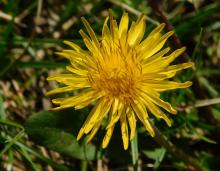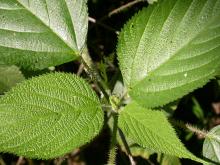Wildflowers, Grasses and Other Nonwoody Plants
Media

Species Types
Scientific Name
Fragaria virginiana
Description
Wild strawberry is one of the parents of the cultivated strawberry and is one of our prized native wild edibles. It’s also a valuable food for innumerable animals, and it’s attractive in native wildflower gardens.
Media

Species Types
Scientific Name
Taraxacum officinale
Description
The common dandelion is a well-known common weed of lawns, roadsides, and other disturbed places. Originally from Europe, it occurs nearly worldwide.
Media

Species Types
Scientific Name
Lactuca floridana
Description
A true lettuce that can be eaten as a cooked or salad green, Florida lettuce has lavender to purplish blue flowers and grows statewide.
Media

Species Types
Scientific Name
Pyrrhopappus carolinianus
Description
One of several native plants called dandelions, Carolina false dandelion is an annual with sulphur yellow flowers and puffy seedheads.
Media

Species Types
Scientific Name
Oenothera biennis
Description
True to its name, common evening primrose is the most common and widespread evening primrose in Missouri. It is most noticeable late in the season, when it reaches its greatest height and the flowers at the top are most visible.
Media

Species Types
Scientific Name
Cunila origanoides
Description
Sometimes called wild oregano, dittany, like true oregano, is a member of the mint family and can be used as a culinary herb and in teas. Look for it on dry, wooded slopes in Ozark counties.
Media

Species Types
Scientific Name
Capsella bursa-pastoris
Description
Shepherd’s purse is a plant that started in Europe and western Asia and has been introduced nearly worldwide. Like the common dandelion, it has several adaptations that make it a successful colonizer of disturbed soil.
Media

Species Types
Scientific Name
Cardamine bulbosa
Description
Like many of its relatives in the mustard family, spring cress has a bitter or pungent flavor, similar to horseradish. It is sometimes used as a condiment and in salads. Or you could just enjoy the pretty white flowers!
Media

Species Types
Scientific Name
Laportea canadensis
Description
Wood nettle, or stinging nettle, often forms dense stands in bottomland forests, streamsides, and other places. There, canoeists, anglers, and others try to avoid touching its stinging hairs!
Media

Species Types
Scientific Name
Physalis longifolia
Description
Common ground cherry is closely related to the tomatillo, which you’ve probably seen in the grocery store or had in a delicious salsa verde at a Mexican restaurant. The fruits of ground cherry are edible, too.
See Also
About Wildflowers, Grasses and Other Nonwoody Plants in Missouri
A very simple way of thinking about the green world is to divide the vascular plants into two groups: woody and nonwoody (or herbaceous). But this is an artificial division; many plant families include some species that are woody and some that are not. The diversity of nonwoody vascular plants is staggering! Think of all the ferns, grasses, sedges, lilies, peas, sunflowers, nightshades, milkweeds, mustards, mints, and mallows — weeds and wildflowers — and many more!





















